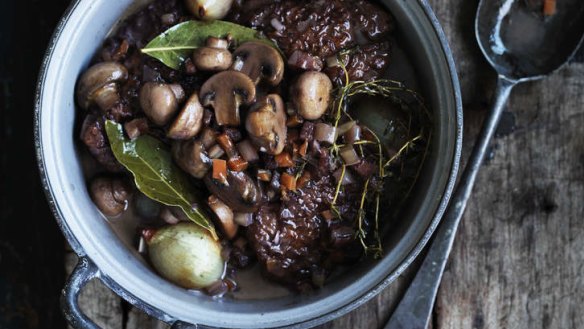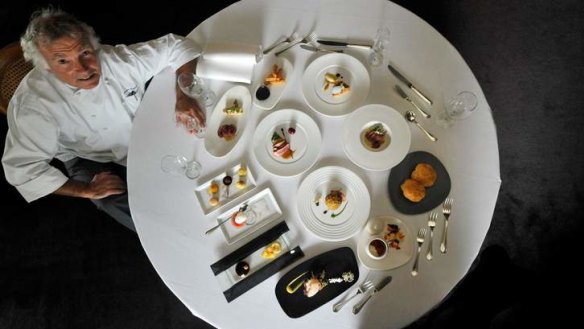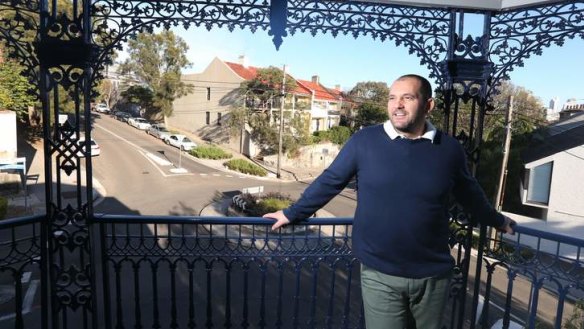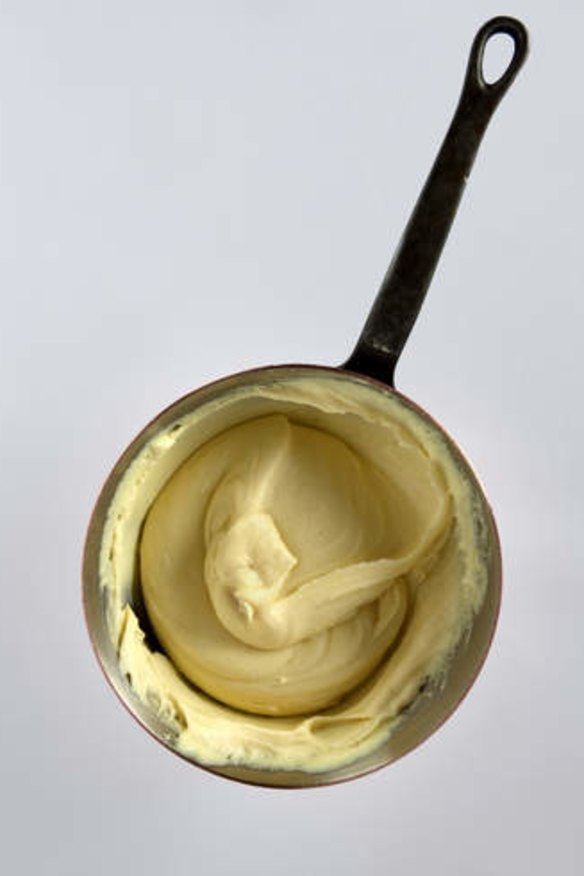How to cook like the French: tips from Guillaume Brahimi and Jacques Reymond

Pardon the puns, but French cooking seems to have taken a beating, whipping and merciless flambéing in recent times. What was once the culinary toast of foodies everywhere has become much maligned: it's too rich, too fussy, too mired in tradition go the naysayers.
The British press regularly take snarky delight in reporting on Parisians queuing 'round the block for Burger King (the chain successfully returned to France just last December after a 16-year absence), or last month's news of residents of a northern town near Lille taking to the streets to protest delays in the construction of a local McDonald's.
True to form, though, the French don't give a merde.
“It says something that French cuisine was the first in the world to be protected by UNESCO's heritage list,” says Parisian-born Guillaume Brahimi, whose new restaurant Guillaume opened in Sydney's Paddington last week. “In France, cooking and eating is a serious thing.”
Such dedication to preparing and consuming food may explain why household Francophiles continue to be drawn to the country's cuisine, its tried and tested techniques, its focus on regional produce, and above all, its romance. You can't exactly listen to Jacques Brel while preparing guacamole, can you?
But what are some simple starting points to entering the proud haute cuisine laid out generations ago by early culinary superstars like Careme and Escoffier and endlessly republished bibles including Mathiot's Je Sais Cuisiner and Larousse Gastronomique? Here are some tips...

To cook like the French, you need to eat like the French
Scoffing down a quinoa salad at your office desk? That's what the French would call a no-no (perhaps something with more expletives). “The French take dining seriously. It's not like here where most of the time we only get one meal,” says Jacques Reymond, who has kept busy since hanging up his apron at his celebrated, eponymous Melbourne restaurant last year (he's currently working with frozen cuisine service Dish'd, and designing the menu for a new bistro to be run by his children). “In France, there is a break of two hours at lunch, where everything closes down, so the people go home or to a restaurant to eat properly.”
“A normal French meal is a long sit down thing,” adds Brahimi. “You would probably start with a crudite, some raw vegetables with a vinaigrette. Then after that, it's a nice piece of steak or some roast chicken or a piece of fish and some seasonal vegetables. Maybe then you might be able to squeeze in a piece of cheese, and a small slice of tart. That would be a perfect lunch.”

Pantry essentials
Q: Who is the loneliest Frenchman? A: He who is lactose intolerant. If you suffer from a similar affliction, you might want to look away now.
“Dairy products: butter, cheese, cream. They are the most important items, and used on a daily basis in French cooking,” says Reymond, listing Comte cheese and Beurre D'isgny (a cow's milk butter from the Baie de Vays area of Normandy) as his must-haves.

And while Brahimi concurs – he highlights local varieties including Myrtleford butter from Victoria and Holy Goat cheeses, and counts bread as another essential (“At lunch, at dinner, bread is always there for the French,” he says, recommending Iggy's sourdough, which he uses both in the restaurant and at home) – he notes recent changes to these most French of French staples.
“Butter is a key ingredient in French cooking, but I think the days of French cooking being heavy and only with butter are over,” he says. “The French use olive oil just as much these days, and they've adapted their cooking much more than they ever did before. We all have to eat more healthy; it's no different for the French.”
Cook seasonally
Much of what we now take for granted as best home-cooking practice has its basis in the French cuisine du marche ('cooking from the market'). “I think if you want to cook like the French, you have to follow the season,” says Brahimi. “Going to the market and picking the best produce available. This is something all French people do – not only professional chefs, but also in the household.“
He suggests a simple French dish of asperges blanchies ('blanched asparagus') to set you on your way. “Coming into spring, this is a beautiful dish,” says Brahimi. “Get some asparagus, peel at the last moment, blanch in boiling water, make a nice vinaigrette for it with garlic and butter, and finish it with some torn fresh tarragon. Just make sure you have some icy water to put the asparagus in once they cook, and don't overcook them. After that, there is no problem.”
Start with sauces
The sauce is a staple of French cooking, something you'd clearly know if you watched Manu Feildel stern-facedly asking for “More sauce!” on every episode of My Kitchen Rules. Considering they're often made from a similar starting base - learning a hollandaise (egg and butter) or a roux (butter and flour) will score you dozens of adaptable recipes – they're a good place to start, says Brahimi.
“You need to know how to make all the classics,” he says. “A béarnaise sauce, hollandaise, red wine jus, beurre blanc, sauce poivrade [pepper sauce]... These are all classic French sauces and they're not hard; you just have to follow the recipe.”
Master the classics (or at least a couple of them)
Your foray into French cooking doesn't necessarily need to involve emulating the 720 pages of Julia Child's Mastering The Art Of French Cooking (really don't do that, it's been done) – there are countless 'quintessential' French dishes to practice, says Reymond.
“The culture of France is based on regions, so there is no one quintessential French dish,” he says. “Each region has its own traditional dishes. If you're in the mountains, they use a lot of cheese. If you are by the sea, they use a lot of fish. I am from Burgundy – we work a lot with chickens. But things like cheese soufflé, crepe suzette, croque gratin, bouillabaisse... These are all traditional French dishes to learn.”
“Making a stew, like a boeuf bourguignon, would be a great start. There are many recipes around and they're quite easy to do,” adds Brahimi. “Also a dessert, like a lemon tart or a crème brulee... They are all French classics, and not difficult to accomplish.”
Improvise at your own risk
Reymond points to his own Burgundy stomping grounds to highlight a classic dish the Francophile should master: coq au vin.
He recommends finding a recipe that appeals – don't bother looking in Escoffier's Le Guide Culinaire (1903); the French haute cuisine pioneer notoriously snubbed the dish in his 943-page tome – sticking to it, and avoiding the false allure of 'shortcuts'.
“Use a high quality wine – the better the wine, the better the dish,” Reymond offers by way of a tip, but only after adding a key disclaimer with typical Gaelic bravado. "There is no 'secret' to recipes if they are traditional, you have to understand that,” says Reymond.
“You don't modify the traditional recipe; you respect it. It's a sign of respect and satisfaction. You don't put a gimmick or anything like that. It doesn't exist in French cuisine, sir. That is the true attitude of French cooking.”
On chicken and modernising French cuisine
“Poultry is for cookery what canvas is for painting,” wrote the great French epicure Brillat-Savarin about two centuries ago. “It is served to us boiled, roast, hot or cold, whole or in portions, with or without sauce, and always with equal success.”
Yes, the French certainly love chicken.
“Roast chicken is the ABC of French cooking,” says Brahimi. “Every household sits down to share one at least once a month.” But reflecting his reputation for fusion, Brahimi's take on French classics often take some liberties with tradition. His roast chicken with pomme fondant and salsa verde (recipe below) is a prime example.
While the dish might usually be served with a broth-based sauce (say, a simple jus using the pan juices, or a richer veloute), Brahimi opts for a salsa verde of blitzed ligurian olives, anchovies and capers. “The salsa verde is my mother's touch,” says the chef. “She would always serve it with roast chicken. It lends a fresh and light component to the dish.”
The roast's pairing with pomme fondant is a touch more old-school, a classic French side dish that should evoke ghosts of Parisian bistros. The potatoes are pan-fried in butter and cooked in chicken stock, which is absorbed for a richer flavour. The resulting spuds have a crusty outside glaze, and soft, mashy texture on the inside.
“The secret to perfecting pomme fondant is practice,” says Brahimi, arguing that your focus need not be diverted by some measly spuds (or even a paired Burgundy – “White or red both work great,” he adds). “Checking that the chicken is cooked properly is what requires your main attention.”
Recipe: Guillaume Brahimi's roast chicken with pomme fondant and salsa verde
Serves 4
Ingredients
1 x 1.8kg Barossa chicken
12 desiree potatoes
200ml chicken stock
50g unsalted butter
1 bunch thyme
1 stick bay leaves
1 head garlic
For salsa verde
1 bunch flat leaf parsley (leaves only)
40g ligurian olives (pitted)
20g capers
1 salted anchovy
100ml extra virgin olive oil
1/2 lemon (juice only)
Method
1. Pre-heat the oven to 200C. Oil the chicken and sprinkle with salt.
2. Fill the chicken cavity with half of the thyme, half of the garlic and three bay leaf leaves, place the remaining herbs on the base of the roasting tray, and place chicken on top. Place in the oven.
3. Using a 5cm cutter, cut out the potatoes and trim the top and bottom, use a knife to trim the top.
4. When chicken has been cooking for 30 minutes, place a frypan on high heat, add oil to the pan and place the potatoes turned side down. Cook until nice and golden, add the butter and allow to foam.
5. Pour entire ingredients of pan into the roasting tray, leaving the coloured side of the potato facing up, add hot stock and place the chicken back in the oven for 45 minutes.
6. Check the chicken is cooked, remove it from the tray and allow to rest. Place the tray onto a burner and turn the potato, allow the potatoes to absorb all liquor and glaze. Turnover and serve with chicken cut into quarters.
For salsa verde
1. Place all ingredients in a blender and blend until smooth and season.
Appears in these collections
The best recipes from Australia's leading chefs straight to your inbox.
Sign up